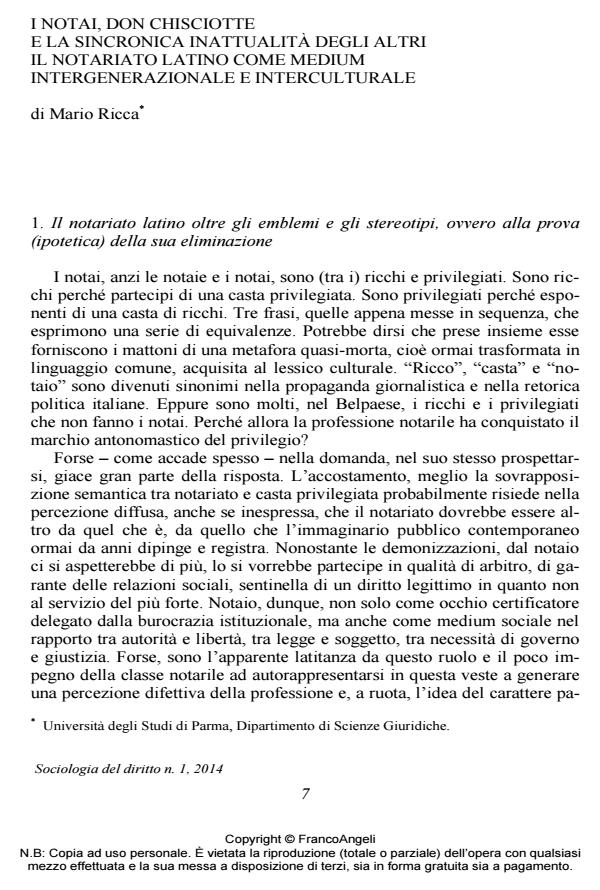Notaries, Don Quixote and the synchronic out-datedness of others. The Latin notary as an intergenerational and intercultural medium
Journal title SOCIOLOGIA DEL DIRITTO
Author/s Mario Ricca
Publishing Year 2014 Issue 2014/1 Language Italian
Pages 25 P. 7-31 File size 221 KB
DOI 10.3280/SD2014-001001
DOI is like a bar code for intellectual property: to have more infomation
click here
Below, you can see the article first page
If you want to buy this article in PDF format, you can do it, following the instructions to buy download credits

FrancoAngeli is member of Publishers International Linking Association, Inc (PILA), a not-for-profit association which run the CrossRef service enabling links to and from online scholarly content.
This essay analyses the profession of the notary from an unusual anthropologicalsociological perspective. Something of a scapegoat for contemporary journalism, the institution of the Latin notary has inhabited Italy’s recent history, playing an important role in the process of juridification of everyday life, so of the formation of living law. The problem is to ascertain whether this function also continues within the shell of the activity conducted by individual notaries today: a complex operation, especially in communication terms. In order to achieve its purpose, while keeping its distance from stereotypes and commonplaces, the text transforms the affluent notary who populates our popular imagery into a mimic of Don Quixote taking issue with the usual way of thinking, a semi-hero devoted to demonstrating the synchronic currency of the weakest members of society, within the framework of the law. Undergoing this transmutation, the institution of the notary is found to offer an unexpected metaphor of modernity, of its ambiguous parabola and of its unachieved potential.
Keywords: The Latin notary ‒ Otherness; Intercultural ‒ Legal ethnology ‒ Modernity
- Blomley, Nicholas, David Delaney & Richard T. Ford (a cura di), 2001. The Legal Geographies Reader. Oxford & Malden (MA): Blackwell.
- Cohen, Stanley, 2002. Stati di negazione. La rimozione del dolore nella società contemporanea. Tr. it. Roma: Carocci.
- Delaney, David, 2010. The Spatial, the Legal and the Pragmatics of Worldmaking. Nomospheric Investigations. Abingdon & New York: Routledge.
- Dewey, John, [1934] 1995. Arte come Esperienza. Tr. it. Firenze: La Nuova Italia.
- Fabian, Johannes, [1983] 2000. Il tempo e gli altri. La politica del tempo in antropologia. Tr. it. Napoli: L’ancora del Mediterraneo.
- Gibbs, Raymond W. 2005. Embodiment and Cognitive Science. Cambridge: Cambridge University Press.
- Holder, Jane, & Carolyn Harrison (a cura di), 2002. Law and Geography. Oxford - New York: Oxford University Press.
- Ingold, Tim, [2000] 2001. Tre in uno. Come eliminare le distinzioni tra corpo, mente e cultura. In Id., Ecologia della cultura. Tr. it. Roma, Meltemi.
- Peirce, Charles S., [1868] 1984. Questioni concernenti certe pretese facoltà umane.
- In Id., Le leggi dell’ipotesi. Antologia dai Collected Papers. Tr. it. Milano: Bompiani.
- Quaranta, Ivo, & Mario Ricca, 2012. Malati fuori luogo. Medicina interculturale. Milano: Raffaello Cortina.
- Ricca, Mario, 2008a. Oltre Babele. Codici per una democrazia interculturale. Bari:
- Dedalo. —, 2008b. Dike meticcia. Rotte di diritto interculturale. Soveria Mannelli (CZ): Rubbettino.
- —, 2011a. Polifemo. La cecità dello straniero, Palermo: Torri del Vento.
- —, 2011b, Cultura come energia rinnovabile. In Wanda Cortese (a cura di), Insularità, Energie rinnovabili e Tutela del paesaggio. Palermo: Torri del Vento Edizioni.
- —, 2012. Pantheon. Agenda della laicità interculturale. Palermo: Torri del Vento.
- —, 2013a. Culture interdette. Modernità, migrazioni, diritto interculturale. Torino: Bollati Boringhieri.
- —, 2013b. Il tradimento delle immagini tra kirpan e trasformazioni interculturali. Cultura vs. competenza culturale nel mondo del diritto, in E/C, Rivista telematica dell’Associazione Italiana di Studi Semiotici, www.ec-aiss.it, pubblicato in rete il 21 maggio 2013.
- Santoro, Marco, 2004. Il notariato nell’Italia contemporanea. Milano: Giuffrè.
- Schütz, Alfred, [1971, 1955] Don Chisciotte e il problema della realtà. Trad. it. Roma, Armando Editore.
- Shiner, Larry, [2003] 2010. L’invenzione dell’arte. Una storia culturale. Trad. it. Torino, Einaudi.
- Sini, Carlo, 2009. L’uomo, la macchina, l’automa. Lavoro e conoscenza tra futuro prossimo e passato remoto. Torino: Bollati Boringhieri
- Intercultural Spaces of Law Mario Ricca, pp.291 (ISBN:978-3-031-27435-0)
Mario Ricca, I notai, don chisciotte e la sincronica inattualità degli altri il notariato latino come medium intergenerazionale e interculturale in "SOCIOLOGIA DEL DIRITTO " 1/2014, pp 7-31, DOI: 10.3280/SD2014-001001